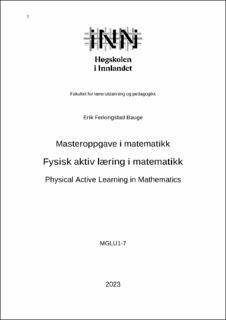| dc.contributor.advisor | | |
| dc.contributor.author | Bauge, Erik Ferkingstad | |
| dc.date.accessioned | 2023-06-27T16:10:16Z | |
| dc.date.available | 2023-06-27T16:10:16Z | |
| dc.date.issued | 2023 | |
| dc.identifier | no.inn:inspera:136491409:37705430 | |
| dc.identifier.uri | https://hdl.handle.net/11250/3073696 | |
| dc.description.abstract | Denne masteroppgaven er et resultat av et ønske om å lære mer om fysisk aktiv læring slik at jeg kan benytte meg av det i egen undervisning som fremtidig lærer. Problemstillingen som er lagt til grunn for studien er: Hvordan legger lærere til rette for fysisk aktiv læring i matematikk?
For å kunne besvare problemstillingen ble det gjennomført en metodetriangulering mellom semistrukturerte kvalitative forskingsintervju og observasjon av lærere og elever i fysisk aktiv lærings (FAL) kontekster. Informantenes erfaringer fra undervisning med FAL ble analysert og diskutert opp mot et teoretisk rammeverk som la grunnlag for studien. Det er blant annet redegjort for ulike oppfatninger knyttet til FAL, undervisningsplanlegging, samt tidligere forskning på FAL. Dette ble brukt til å tolke og forstå de erfaringene og beskrivelsene informantene fortalte om.
Funnene i oppgaven er at informantene har like erfaringer med FAL i matematikk. Informantene definerer begrept likt, men praktiserer det forskjellig. De opplever at elevene har økt motivasjon og deltakelse i FAL undervisningen, kontra den mer tradisjonelle undervisningen hvor elevene er stillesittende. Jeg får tilgang til informantenes erfaringer og oppfatninger knyttet FAL som metode i matematikk og et innblikk i hvordan de planlegger FAL undervisningen. Bevegelsene og aktivtetene som brukes av informantene i FAL, viser preg av å lære i bevegelse. Bridging, eller brobygging er et begrep som knyttet til planleggingen av FAL aktiviteter. Dette går ut på hvordan lærerne skal kunne forflytte seg over broer slik at elevene skal kunne forstå sammenhenger mellom det fysiske som oppstår i timene og det teoretiske de finner i lærebøkene sine. | |
| dc.description.abstract | This master thesis is a result of a wish to learn more about physical active learning, such that I can implement it in my own lessons as a future teacher. The title of this thesis is Physical Active Learning in Mathemathics, and the research was based on the following question: How do teachers facilitate physically active learning in mathematics?
In order to answer this question, a method triangulation was carried out between semi-structural qualitative research interviews and observation of teachers and pupils in physically active learning (PAL) contexts. The informants’ experiences from teaching with PAL were analyzed and discussed against a theoretical framework that laid the basis for the study. Among other things, various perceptions related to PAL, planning, as well as previous research on PAL are explained. This was used to interpret and understand the experiences and descriptions the informants told me about.
The findings in the thesis are that the informants have similar experiences with PAL in mathematics. The informants define the term in the same way but practice it differently. They find that the pupils have increased motivation and participation in PAL teaching, compared to the more traditional teaching where the students are sedentary. I get access to the informants‘ experiences and perceptions related to PAL as a method in mathematics and an insight into how they plan for PAL. The movements and activities used by the informants in PAL show signs of learning in motion. Bridging is a term that is linked to the planning of PAL activities. This involves how the teachers should be able to move across bridges so that the pupils are able to understand connections between the physical things that occur in the lessons and the theoretical things they find in their textbooks. | |
| dc.language | nob | |
| dc.publisher | Inland Norway University | |
| dc.title | Fysisk aktiv læring i matematikk | |
| dc.type | Master thesis | |
